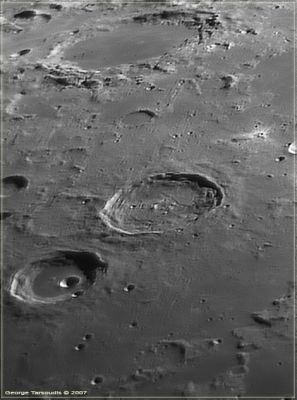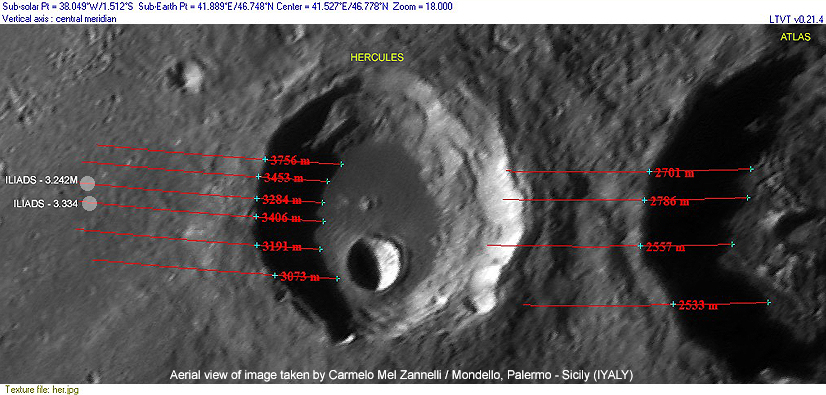Difference between revisions of "Hercules"
(Created page with "<div id="content_view" class="wiki" style="display: block"> =Hercules= {| class="wiki_table" | Lat: 46.7°N, Long: 39.1°E, Diam: 69 km, Depth: 2.32 km, [http://the-moon.w...") |
|||
| Line 3: | Line 3: | ||
{| class="wiki_table" | {| class="wiki_table" | ||
| | | | ||
| − | Lat: 46.7°N, Long: 39.1°E, Diam: 69 km, Depth: 2.32 km, [http://the-moon. | + | Lat: 46.7°N, Long: 39.1°E, Diam: 69 km, Depth: 2.32 km, [http://the-moon.us/wiki/R%C3%BCkl%2014 Rükl: 14], [http://the-moon.us/wiki/Stratigraphy Eratosthenian]<br /> |
|} | |} | ||
<div id="toc"> | <div id="toc"> | ||
=Table of Contents= | =Table of Contents= | ||
| − | <div style="margin-left: 1em">[#Hercules Hercules]</div><div style="margin-left: 2em">[#Hercules-Images Images]</div><div style="margin-left: 2em">[#Hercules-Maps Maps]</div><div style="margin-left: 2em">[#Hercules-Description Description]</div><div style="margin-left: 2em">[#Hercules-Description: Elger Description: Elger]</div><div style="margin-left: 2em">[#Hercules-Description: Wikipedia Description: Wikipedia]</div><div style="margin-left: 2em">[#Hercules-Additional Information Additional Information]</div><div style="margin-left: 2em">[#Hercules-Nomenclature Nomenclature]</div><div style="margin-left: 2em">[#Hercules-LPOD Articles LPOD Articles]</div><div style="margin-left: 2em">[#Hercules-Bibliography Bibliography]</div></div>[http://www.lpod.org/coppermine/displayimage.php?pid=1401&fullsize=1 [[Image:normal_20060324_AtlasHercules_Tar.jpg|external image normal_20060324_AtlasHercules_Tar.jpg]]]<br /> ''[http://lpod.org/coppermine/displayimage.php?pos=-1401 George Tarsoudis]'' '''Hercules''' is at the bottom, [http://the-moon. | + | <div style="margin-left: 1em">[#Hercules Hercules]</div><div style="margin-left: 2em">[#Hercules-Images Images]</div><div style="margin-left: 2em">[#Hercules-Maps Maps]</div><div style="margin-left: 2em">[#Hercules-Description Description]</div><div style="margin-left: 2em">[#Hercules-Description: Elger Description: Elger]</div><div style="margin-left: 2em">[#Hercules-Description: Wikipedia Description: Wikipedia]</div><div style="margin-left: 2em">[#Hercules-Additional Information Additional Information]</div><div style="margin-left: 2em">[#Hercules-Nomenclature Nomenclature]</div><div style="margin-left: 2em">[#Hercules-LPOD Articles LPOD Articles]</div><div style="margin-left: 2em">[#Hercules-Bibliography Bibliography]</div></div>[http://www.lpod.org/coppermine/displayimage.php?pid=1401&fullsize=1 [[Image:normal_20060324_AtlasHercules_Tar.jpg|external image normal_20060324_AtlasHercules_Tar.jpg]]]<br /> ''[http://lpod.org/coppermine/displayimage.php?pos=-1401 George Tarsoudis]'' '''Hercules''' is at the bottom, [http://the-moon.us/wiki/Atlas Atlas] is in the middle and [http://the-moon.us/wiki/Endymion Endymion] is at the top.<br /> <br /> |
==Images== | ==Images== | ||
[http://www.lpod.org/coppermine/thumbnails.php?album=search&type=full&search=Hercules LPOD Photo Gallery] [http://www.lpi.usra.edu/resources/lunar_orbiter/bin/srch_nam.shtml?Hercules%7C0 Lunar Orbiter Images] [http://www.lpi.usra.edu/resources/apollo/search/feature/?feature=Hercules Apollo Images]<br /> <br /> | [http://www.lpod.org/coppermine/thumbnails.php?album=search&type=full&search=Hercules LPOD Photo Gallery] [http://www.lpi.usra.edu/resources/lunar_orbiter/bin/srch_nam.shtml?Hercules%7C0 Lunar Orbiter Images] [http://www.lpi.usra.edu/resources/apollo/search/feature/?feature=Hercules Apollo Images]<br /> <br /> | ||
==Maps== | ==Maps== | ||
| − | ''([http://the-moon. | + | ''([http://the-moon.us/wiki/LAC%20zone LAC zone] 27A1)'' [http://www.lpi.usra.edu/resources/mapcatalog/LAC/lac27/ LAC map] [http://www.lpi.usra.edu/resources/mapcatalog/usgs/I841/ Geologic map]<br /> <br /> |
==Description== | ==Description== | ||
'''Hercules''' is the smaller of the Greek hero two-some in this part of the Moon, and it has a flat floor.<br /> <br /> | '''Hercules''' is the smaller of the Greek hero two-some in this part of the Moon, and it has a flat floor.<br /> <br /> | ||
==Description: Elger== | ==Description: Elger== | ||
| − | ''([http://the-moon. | + | ''([http://the-moon.us/wiki/IAU%20Directions IAU Directions])'' HERCULES.--The western companion of [http://the-moon.us/wiki/Atlas Atlas], a fine ring-plain, about 46 miles in diameter, with a complex border, rising some 11,000 feet above a depressed floor. There are few formations of its class and size which display so much detail in the shape of terraces, apparent landslips, and variation in brightness. In the interior, S.W. of the centre, is a very conspicuous crater, which is visible as a bright spot when the formation itself is hardly traceable, two large craterlets slightly N. of the centre, and several faint little spots on the west of them. The latter, detected some years ago by Herr Hackel of Stuttgart, are arranged in the form of a horse-shoe. There are two small contiguous craters on the S.W. wall, one of which, a difficult object, was recently detected by Mr. W.H. Maw, F.R.A.S. The well-known wedge-shaped protuberance on the S. wall is due to a large irregular depression. On the bright inner slope of the N. wall are manifest indications of a landslip.<br /> <br /> |
==Description: Wikipedia== | ==Description: Wikipedia== | ||
[http://en.wikipedia.org/wiki/Hercules_(crater) Hercules]<br /> <br /> | [http://en.wikipedia.org/wiki/Hercules_(crater) Hercules]<br /> <br /> | ||
==Additional Information== | ==Additional Information== | ||
| − | * Depth data from [http://the-moon. | + | * Depth data from [http://the-moon.us/wiki/Kurt%20Fisher%20crater%20depths Kurt Fisher database] |
** Westfall, 2000: 2.32 km | ** Westfall, 2000: 2.32 km | ||
** Viscardy, 1985: 3.2 km | ** Viscardy, 1985: 3.2 km | ||
** Cherrington, 1969: 3.81 km | ** Cherrington, 1969: 3.81 km | ||
** Measurements using both [http://ltvt.wikispaces.com/LTVT LTVT] and the [http://pub.lmmp.nasa.gov/redmine/projects/lmmpwiki/wiki/ILIADS ILIADS]’s software give an average depth of 3.2 km in [http://lpod.org/coppermine/displayimage.php?pos=-4320 Carmelo Mel Zannelli’s] image taken from the [http://www.lpod.org/coppermine/ LPOD Photo Gallery]. <span class="membersnap">- [http://www.wikispaces.com/user/view/JohnMoore2 [[Image:JohnMoore2-lg.jpg|16px|JohnMoore2]]] [http://www.wikispaces.com/user/view/JohnMoore2 JohnMoore2]</span> | ** Measurements using both [http://ltvt.wikispaces.com/LTVT LTVT] and the [http://pub.lmmp.nasa.gov/redmine/projects/lmmpwiki/wiki/ILIADS ILIADS]’s software give an average depth of 3.2 km in [http://lpod.org/coppermine/displayimage.php?pos=-4320 Carmelo Mel Zannelli’s] image taken from the [http://www.lpod.org/coppermine/ LPOD Photo Gallery]. <span class="membersnap">- [http://www.wikispaces.com/user/view/JohnMoore2 [[Image:JohnMoore2-lg.jpg|16px|JohnMoore2]]] [http://www.wikispaces.com/user/view/JohnMoore2 JohnMoore2]</span> | ||
| − | ** [http://the-moon. | + | ** [http://the-moon.us/wiki/file/detail/hercules-ltvt.jpg [[Image:hercules-ltvt.jpg|external image hercules-ltvt.jpg?size=64]]] (''click for larger image'') |
* Depth is from the less accurate LAC 27. | * Depth is from the less accurate LAC 27. | ||
| − | * [http://the-moon. | + | * [http://the-moon.us/wiki/Central%20peak%20composition Central peak composition]: GNTA1 ([http://the-moon.us/wiki/Tompkins%20%26%20Pieters%2C%201999 Tompkins & Pieters, 1999]) |
| − | * Satellite craters '''Hercules D, E''' and '''G''' are on the [http://the-moon. | + | * Satellite craters '''Hercules D, E''' and '''G''' are on the [http://the-moon.us/wiki/ALPO%20list%20of%20bright%20ray%20craters ALPO list of bright ray craters]. |
| − | * Satellite craters '''Hercules C, D''' and '''G''' are on the [http://the-moon. | + | * Satellite craters '''Hercules C, D''' and '''G''' are on the [http://the-moon.us/wiki/ALPO%20list%20of%20banded%20craters ALPO list of banded craters] |
| − | * TSI = 35, CPI = 25, FI = 5; MI =65 [http://the-moon. | + | * TSI = 35, CPI = 25, FI = 5; MI =65 [http://the-moon.us/wiki/Smith%20and%20Sanchez%2C%201973 Smith and Sanchez, 1973] |
* On 19th February 1885 Gray observed a small crater near '''Hercules''' glow dull red 'with vivid contrast'. Source: V.A.Firsoff's ''The Old Moon and the New'' (1969), page 185.<span class="membersnap">- [http://www.wikispaces.com/user/view/DannyCaes [[Image:DannyCaes-lg.jpg|16px|DannyCaes]]] [http://www.wikispaces.com/user/view/DannyCaes DannyCaes] <small>May 19, 2012</small></span> | * On 19th February 1885 Gray observed a small crater near '''Hercules''' glow dull red 'with vivid contrast'. Source: V.A.Firsoff's ''The Old Moon and the New'' (1969), page 185.<span class="membersnap">- [http://www.wikispaces.com/user/view/DannyCaes [[Image:DannyCaes-lg.jpg|16px|DannyCaes]]] [http://www.wikispaces.com/user/view/DannyCaes DannyCaes] <small>May 19, 2012</small></span> | ||
<br /> | <br /> | ||
==Nomenclature== | ==Nomenclature== | ||
| − | * The [http://the-moon. | + | * The [http://the-moon.us/wiki/IAU IAU] name is the Latin spelling for Greek [http://the-moon.us/wiki/Nomenclature-Mythological%20Figures mythological hero] [http://en.wikipedia.org/wiki/Heracles Heracles]. |
| − | * The name was given by [http://the-moon. | + | * The name was given by [http://the-moon.us/wiki/Riccioli Riccioli] and became Catalog Entry 452 in the ''[http://the-moon.us/wiki/Collated%20List Collated List]'' and in ''[http://the-moon.us/wiki/Named%20Lunar%20Formations Named Lunar Formations]''. |
| − | * [http://the-moon. | + | * [http://the-moon.us/wiki/Felix%20Chemla%20Lam%C3%A8ch Felix Chemla Lamèch] is reported to have proposed '''''Kephalinos''''' as a replacement name for '''Hercules F''', but the IAU did not accept his proposal. Research: Ewen A. [http://the-moon.us/wiki/Whitaker Whitaker] and Danny Caes (August 2003, mail correspondence). |
| − | * The name '''Hercules''' is absent in the book ''[http://the-moon. | + | * The name '''Hercules''' is absent in the book ''[http://the-moon.us/wiki/Who%27s%20Who%20On%20the%20Moon Who's Who On the Moon]'' by Elijah E. Cocks and Josiah C. Cocks (Tudor Publishers, 1995), but not because it is a mythological figure: he names '''Icarus''' and '''Daedalus''' (also mythological figures) are included in the book. Error detected by Danny Caes. |
* The names '''Hercules''' and '''Cepheus''' are the only two in the gazetteer of official lunar nomenclature which are also the names of constellations in the celestial northern hemisphere.<span class="membersnap">- [http://www.wikispaces.com/user/view/DannyCaes [[Image:DannyCaes-lg.jpg|16px|DannyCaes]]] [http://www.wikispaces.com/user/view/DannyCaes DannyCaes] <small>Apr 25, 2010</small></span> | * The names '''Hercules''' and '''Cepheus''' are the only two in the gazetteer of official lunar nomenclature which are also the names of constellations in the celestial northern hemisphere.<span class="membersnap">- [http://www.wikispaces.com/user/view/DannyCaes [[Image:DannyCaes-lg.jpg|16px|DannyCaes]]] [http://www.wikispaces.com/user/view/DannyCaes DannyCaes] <small>Apr 25, 2010</small></span> | ||
<br /> | <br /> | ||
==LPOD Articles== | ==LPOD Articles== | ||
| − | [http:// | + | [http://www2.lpod.org/wiki/November_26,_2006 Hiding a Mouse.] [http://www2.lpod.org/wiki/January_29,_2006 A Tale of Two Craters] [http://www2.lpod.org/wiki/September_5,_2004 Lunar Super-Heroes] [http://www2.lpod.org/wiki/October_21,_2007 A Wonderful Corner] [http://lpod.wikispaces.com/June%201%2C%202009 Ejecta Tales]<br /> <br /> |
==Bibliography== | ==Bibliography== | ||
Revision as of 19:16, 11 April 2018
Contents
Hercules
|
Lat: 46.7°N, Long: 39.1°E, Diam: 69 km, Depth: 2.32 km, Rükl: 14, Eratosthenian |
Table of Contents

George Tarsoudis Hercules is at the bottom, Atlas is in the middle and Endymion is at the top.
Images
LPOD Photo Gallery Lunar Orbiter Images Apollo Images
Maps
(LAC zone 27A1) LAC map Geologic map
Description
Hercules is the smaller of the Greek hero two-some in this part of the Moon, and it has a flat floor.
Description: Elger
(IAU Directions) HERCULES.--The western companion of Atlas, a fine ring-plain, about 46 miles in diameter, with a complex border, rising some 11,000 feet above a depressed floor. There are few formations of its class and size which display so much detail in the shape of terraces, apparent landslips, and variation in brightness. In the interior, S.W. of the centre, is a very conspicuous crater, which is visible as a bright spot when the formation itself is hardly traceable, two large craterlets slightly N. of the centre, and several faint little spots on the west of them. The latter, detected some years ago by Herr Hackel of Stuttgart, are arranged in the form of a horse-shoe. There are two small contiguous craters on the S.W. wall, one of which, a difficult object, was recently detected by Mr. W.H. Maw, F.R.A.S. The well-known wedge-shaped protuberance on the S. wall is due to a large irregular depression. On the bright inner slope of the N. wall are manifest indications of a landslip.
Description: Wikipedia
Additional Information
- Depth data from Kurt Fisher database
- Westfall, 2000: 2.32 km
- Viscardy, 1985: 3.2 km
- Cherrington, 1969: 3.81 km
- Measurements using both LTVT and the ILIADS’s software give an average depth of 3.2 km in Carmelo Mel Zannelli’s image taken from the LPOD Photo Gallery. - JohnMoore2 JohnMoore2
 (click for larger image)
(click for larger image)
- Depth is from the less accurate LAC 27.
- Central peak composition: GNTA1 (Tompkins & Pieters, 1999)
- Satellite craters Hercules D, E and G are on the ALPO list of bright ray craters.
- Satellite craters Hercules C, D and G are on the ALPO list of banded craters
- TSI = 35, CPI = 25, FI = 5; MI =65 Smith and Sanchez, 1973
- On 19th February 1885 Gray observed a small crater near Hercules glow dull red 'with vivid contrast'. Source: V.A.Firsoff's The Old Moon and the New (1969), page 185.- DannyCaes DannyCaes May 19, 2012
Nomenclature
- The IAU name is the Latin spelling for Greek mythological hero Heracles.
- The name was given by Riccioli and became Catalog Entry 452 in the Collated List and in Named Lunar Formations.
- Felix Chemla Lamèch is reported to have proposed Kephalinos as a replacement name for Hercules F, but the IAU did not accept his proposal. Research: Ewen A. Whitaker and Danny Caes (August 2003, mail correspondence).
- The name Hercules is absent in the book Who's Who On the Moon by Elijah E. Cocks and Josiah C. Cocks (Tudor Publishers, 1995), but not because it is a mythological figure: he names Icarus and Daedalus (also mythological figures) are included in the book. Error detected by Danny Caes.
- The names Hercules and Cepheus are the only two in the gazetteer of official lunar nomenclature which are also the names of constellations in the celestial northern hemisphere.- DannyCaes DannyCaes Apr 25, 2010
LPOD Articles
Hiding a Mouse. A Tale of Two Craters Lunar Super-Heroes A Wonderful Corner Ejecta Tales
Bibliography
- Hercules F (Lamech's "Kephalinos"): Mapping and Naming the Moon; a history of lunar cartography and nomenclature (Ewen A. Whitaker).
This page has been edited 1 times. The last modification was made by - tychocrater tychocrater on Jun 13, 2009 3:24 pm - afx3u2